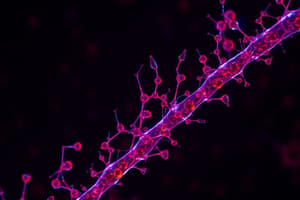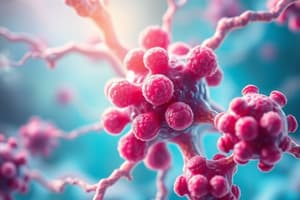Podcast
Questions and Answers
Which of the following scenarios best illustrates the principle of homeostasis in a biological system?
Which of the following scenarios best illustrates the principle of homeostasis in a biological system?
- A mammal maintaining a constant body temperature despite fluctuations in the external temperature. (correct)
- Seasonal migration of bird populations to optimize resource availability and breeding conditions.
- The growth of a bacterial colony exponentially increasing in a nutrient-rich environment.
- A plant species evolving to develop drought resistance in response to prolonged arid conditions.
How does the study of molecular biology contribute to our understanding of genetic inheritance?
How does the study of molecular biology contribute to our understanding of genetic inheritance?
- By elucidating the mechanisms through which DNA, RNA, and proteins interact to manifest genetic information. (correct)
- By defining the anatomical structures responsible for trait expression across generations.
- By classifying the morphological differences among species based on observable traits.
- By predicting the ecological distribution of species using mathematical models of gene flow and selection.
What distinguishes archaea from bacteria at a fundamental cellular level, and why is this distinction biologically significant?
What distinguishes archaea from bacteria at a fundamental cellular level, and why is this distinction biologically significant?
- Archaea are multicellular organisms, enabling cooperative behaviors not observed in bacteria.
- Archaea have unique cell membrane lipids and often thrive in extreme environments, indicating different evolutionary adaptations. (correct)
- Archaea possess a nucleus, allowing for more complex cellular processes compared to bacteria.
- Archaea conduct photosynthesis, contributing significantly to global oxygen levels, unlike bacteria.
Considering the hierarchical organization of life, how do ecosystems relate to the concepts of populations, communities, and the physical environment?
Considering the hierarchical organization of life, how do ecosystems relate to the concepts of populations, communities, and the physical environment?
Which of the following represents the most accurate and comprehensive application of cell theory in modern biology?
Which of the following represents the most accurate and comprehensive application of cell theory in modern biology?
How does the study of botany contribute to advancements in fields beyond traditional life sciences?
How does the study of botany contribute to advancements in fields beyond traditional life sciences?
In what way does genetics contribute to understanding the process of evolution?
In what way does genetics contribute to understanding the process of evolution?
How does the concept of evolution help to inform strategies in public health and medicine, particularly in the context of infectious diseases?
How does the concept of evolution help to inform strategies in public health and medicine, particularly in the context of infectious diseases?
In the context of scientific inquiry, how does the formulation of a hypothesis differ from the development of a scientific theory?
In the context of scientific inquiry, how does the formulation of a hypothesis differ from the development of a scientific theory?
Considering the unique properties of water, which of the following scenarios would be most directly compromised if water lost its high heat capacity?
Considering the unique properties of water, which of the following scenarios would be most directly compromised if water lost its high heat capacity?
If a newly discovered organism is found to store energy in the form of long, branched chains of glucose molecules and also possesses a significant amount of unsaturated fats, how would you classify these two types of molecules, respectively?
If a newly discovered organism is found to store energy in the form of long, branched chains of glucose molecules and also possesses a significant amount of unsaturated fats, how would you classify these two types of molecules, respectively?
In the context of cellular metabolism, how do catabolic and anabolic pathways work together to maintain cellular function?
In the context of cellular metabolism, how do catabolic and anabolic pathways work together to maintain cellular function?
Considering the processes of photosynthesis and cellular respiration, which of the following statements accurately describes the flow of energy and matter through these pathways?
Considering the processes of photosynthesis and cellular respiration, which of the following statements accurately describes the flow of energy and matter through these pathways?
If a mutation occurs during meiosis in a parent cell, leading to a nonfunctional protein in the resulting gamete, what is the most likely consequence for the offspring if this gamete participates in fertilization?
If a mutation occurs during meiosis in a parent cell, leading to a nonfunctional protein in the resulting gamete, what is the most likely consequence for the offspring if this gamete participates in fertilization?
How does the concept of 'fitness' in natural selection primarily relate to an organism's characteristics and its environment?
How does the concept of 'fitness' in natural selection primarily relate to an organism's characteristics and its environment?
Considering the different levels of ecological organization, what distinguishes a 'community' from an 'ecosystem'?
Considering the different levels of ecological organization, what distinguishes a 'community' from an 'ecosystem'?
If a stable ecosystem experiences a significant reduction in biodiversity, what is the most likely long-term consequence for the ecosystem's resilience to environmental changes?
If a stable ecosystem experiences a significant reduction in biodiversity, what is the most likely long-term consequence for the ecosystem's resilience to environmental changes?
In the context of climate change, which of the following feedback loops would most likely accelerate the rate of global warming?
In the context of climate change, which of the following feedback loops would most likely accelerate the rate of global warming?
Flashcards
Life Science
Life Science
The scientific study of living organisms and life processes, also known as biology.
Biochemistry
Biochemistry
The study of chemical processes within living organisms, focusing on biomolecules.
Molecular biology
Molecular biology
The study of the molecular basis of biological activity, including DNA, RNA, and proteins.
Cell biology
Cell biology
Signup and view all the flashcards
Genetics
Genetics
Signup and view all the flashcards
Cell theory
Cell theory
Signup and view all the flashcards
Gene theory
Gene theory
Signup and view all the flashcards
Homeostasis
Homeostasis
Signup and view all the flashcards
Observation
Observation
Signup and view all the flashcards
Hypothesis
Hypothesis
Signup and view all the flashcards
Carbohydrates
Carbohydrates
Signup and view all the flashcards
Lipids
Lipids
Signup and view all the flashcards
Metabolism
Metabolism
Signup and view all the flashcards
Photosynthesis
Photosynthesis
Signup and view all the flashcards
Cellular Respiration
Cellular Respiration
Signup and view all the flashcards
DNA
DNA
Signup and view all the flashcards
Natural Selection
Natural Selection
Signup and view all the flashcards
Population
Population
Signup and view all the flashcards
Study Notes
Life science studies living organisms and life processes.
- It examines structure, function, growth, evolution, distribution, and taxonomy.
- Life science is also known as biology.
Sub-Disciplines
- Biochemistry studies chemical processes within living organisms.
- It focuses on the structure and function of biomolecules like proteins, carbohydrates, lipids, and nucleic acids.
- Molecular biology studies the molecular basis of biological activity.
- It explores interactions between DNA, RNA, and proteins.
- Cell biology (cytology) studies the structure, function, and behavior of cells.
- It examines cell organelles, cell division, and cell signaling.
- Genetics is the study of heredity and variation in organisms.
- It examines genes, DNA, and inheritance patterns.
- Microbiology studies microorganisms like bacteria, viruses, fungi, and protozoa.
- It also includes their role in health, disease, and the environment.
- Zoology studies animals, including their anatomy, physiology, behavior, and evolution.
- Botany studies plants, including their physiology, structure, genetics, ecology, distribution, classification, and economic importance.
- Ecology examines the interactions between organisms and their environment.
- Evolution concerns the processes transforming life on Earth, from its earliest forms to today's diversity.
- Physiology studies the normal functions of living organisms and their parts.
- Anatomy studies the structure of living organisms.
Key Concepts
- Cell theory states all living organisms are composed of cells.
- Cells are the basic unit of structure and function in living organisms.
- Gene theory states traits are inherited through genes located on chromosomes.
- Homeostasis is an organism's ability to maintain a stable internal environment despite external changes.
- Evolution is the process by which populations of organisms change over time.
- Ecosystems are communities of living organisms interacting with their physical environment.
Domains of Life
- Bacteria are single-celled prokaryotic organisms lacking a nucleus and other membrane-bound organelles.
- Archaea are single-celled prokaryotic organisms distinct from bacteria, often inhabiting extreme environments.
- Eukarya includes all eukaryotic organisms with cells containing a nucleus and other membrane-bound organelles.
- Kingdoms within Eukarya include protists, fungi, plants, and animals.
Scientific Method
- Observation involves noticing and describing events or processes carefully.
- Hypothesis is a testable explanation for a set of observations.
- Experiment is a procedure to make a discovery, test a hypothesis, or demonstrate a known fact.
- Data analysis is the process of inspecting, cleansing, transforming, and modeling data to discover useful information and inform conclusions.
- Conclusion is a judgment or decision reached by reasoning.
- Scientific theories are well-substantiated explanations incorporating facts, laws, inferences, and tested hypotheses.
Important Molecules
- Water is essential due to its properties as a solvent, its high heat capacity, and its role in biochemical reactions.
- Carbohydrates are the primary energy source and provide structural support.
- Lipids include fats, oils, and steroids, functioning in energy storage, insulation, and cell membrane structure.
- Proteins catalyze reactions, transport molecules, and provide structural support.
- Nucleic acids (DNA and RNA) store and transmit genetic information.
Energy and Metabolism
- Metabolism is the sum of all chemical reactions within an organism.
- Anabolism constructs molecules from smaller units.
- Catabolism breaks down molecules into smaller units to release energy.
- Photosynthesis converts light energy into chemical energy in the form of glucose.
- Cellular respiration breaks down glucose to release energy in the form of ATP.
- ATP (adenosine triphosphate) is the primary energy currency of the cell.
Genetics and Heredity
- DNA (deoxyribonucleic acid) carries genetic information in all living organisms.
- Genes are specific DNA sequences that encode proteins or RNA molecules.
- Chromosomes are structures within cells that contain DNA.
- Meiosis produces gametes (sex cells) with half the number of chromosomes as the parent cell.
- Mitosis results in two daughter cells with the same number and kind of chromosomes as the parent nucleus and is typical of ordinary tissue growth.
- Mutations are changes in the DNA sequence that can lead to genetic variation.
- Inheritance is the process by which traits are passed from parents to offspring.
Evolution and Diversity
- Natural selection is the process where organisms better adapted to their environment survive and reproduce more.
- Adaptation enhances an organism's survival and reproduction.
- Speciation is the process by which new species arise.
- Phylogeny is the evolutionary history of a species or group of species.
- Biodiversity is the variety of life in the world or in a particular habitat or ecosystem.
Ecology and Environment
- Population is a group of individuals of the same species living in the same area.
- Community is an assemblage of populations of different species living in the same area.
- Ecosystem is a community of organisms and their physical environment interacting as a unit.
- Biome is a large geographic area characterized by specific climate conditions, animal populations, and plant communities.
- Food chains/webs describe the flow of energy and nutrients through an ecosystem.
- Trophic levels refer to the position an organism occupies in a food chain.
- Symbiosis describes a close ecological relationship between two organisms of different species.
- Climate change refers to long-term shifts in temperatures and weather patterns, largely due to human activities increasing greenhouse gas emissions.
Studying That Suits You
Use AI to generate personalized quizzes and flashcards to suit your learning preferences.




